
This chapter contains 78 problems of differing degrees of difficulty. To make it extra challenging the motif is not specified and you will have to discover the winning method on your own! Moreover, some of the problems combine motifs, making them combinations, but these won’t be too hard! When you see a good move, look for a better one, because the answers will contain the best moves. However, if there are other moves that win almost as easily (as happens in real games!), we will mention these possibilities.
Before doing any tactical problem, always make sure to count the material before trying to solve it. This will give you a hint as to how to proceed; for instance, if you are behind a piece at the start, then winning a piece only brings you even!
6-1 White to play and win

6-2 White to play and win

6-3 White to play and win
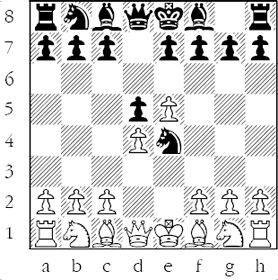
6-4 White to play and win

6-5 White to play and win

6-6 Black to play and win

6-7 Black to play and win

6-8 White to play and win

6-9 White to play and win

6-10 Black to play and win

6-11 Black to play and win

6-12 Black to play and win

6-13 White to play and win

6-14 White to play and win

6-15 White to play and win

6-16 White to play and win

6-17 White to play and win

6-18 White to play and win

6-19 White to play and win

6-20 White to play and win

6-21 White to play and win

6-22 White to play and win

6-23 White to play and win

6-24 White to play and win

6-25 White to play and win

6-26 White to play and stay ahead a pawn

6-27 Black to play and win a pawn

6-28 White to play and win

6-29 Black to play; what is the clincher?

6-30 White to play and win

6-31 White to play and win

6-32 White to play and win

6-33 Black to play and win

6-34 White to play and win

6-35 White to play and win

6-36 White to play and win

6-37 Black to play and win

6-38 Black to play and win

6-39 Black to play and win a pawn

6-40 White to play and win material

6-41 Black to play and win

6-42 White to play what is the clincher?
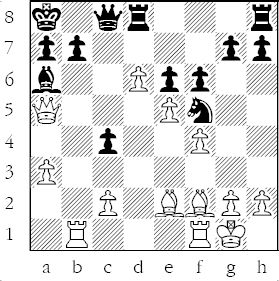
6-43 White to play and win

6-44 White to play and win

6-45 Black to play and win

6-46 White to play and win

6-47 White to play and win

6-48 White to play and win

6-49 Black to play and win

6-50 Black to play and win

6-51 White to play; what is the clincher?

6-52 Black to play and win

6-53 Black to play and win

6-54 Black to play and save the exchange

6-55 White to play and win a pawn

6-56 Black to play and win

6-57 White to play and win

6-58 White to play and draw

6-59 Black to play and mate in two
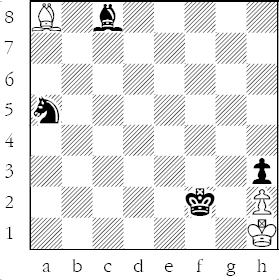
6-60 White to play

6-61 White to play and win
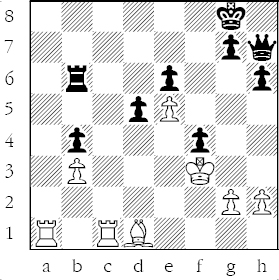
6-62 White to play and win

6-63 White to play and win

6-64 White to play and win

6-65 White to play and win

6-66 Black to play and save all material

6-67 White to play and win a pawn

6-68 White to play and win

6-69 White to play and win
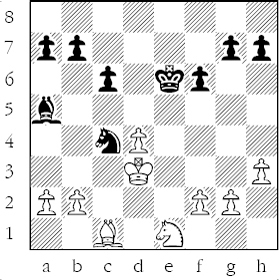
6-70 Black to play and win

6-71 White to play and win

6-72 White to play and win
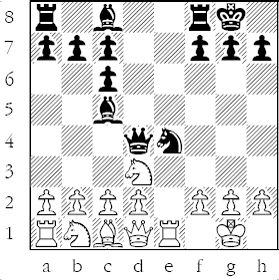
6-73 White to play and win

6-74 White to play and win back a pawn

6-75 White to play and win

6-76 White to play and win

6-77 White to play and win

6-1: 1.Nxe7+ Even though Black has just captured on d3, White should play this zwischenzug to capture with check first. When you see a good move, look for a better one. 1...Kh8 2.Qxd3 Less accurate is 2.Nxc6 Bxe2 3.Rxd7. 2...Qb7 3.Qxd7 and White has won two pieces.
6-2: 1.Qe3 White tries to deflect Black’s queen from guarding against the back rank mate. You can sacrifice anything – even a queen – if the reward is checkmate! This is quicker than 1.c5, which also wins. 1...Qc7 1...Qxe3 2.Rd8# or 1...Qa5 2.Qc5! b5 3.b4!. 2.Qe5 Qb6 3.Qc5 and Black can no longer stop both threats, so White wins the queen or checkmates!
6-3: 1.f3 Notice the knight has no escape squares! 1...e6 The only way to counterattack. 2.fxe4 Delaying this capture by 2.Nh3 or 2.Ne2 is also good. 2...Qh4+ and once White moves the king, he retains a big advantage. But not 3.g3?? Qxe4+, which lets Black win the rook on h1.
6-78 White to play and win

6-4: 1.Nd5 Retreating the bishop is a common mistake! 1.Nd5 is another example of an excellent zwischenzug. 1...Qd8 2.Bxf6 This is much better than 2.Nxf6+ gxf6 3.Bxh6, which is good for White, but not nearly as good. 2...gxf6 3.Qxh6 and the threat of Nxf6+ wins the queen.
6-5: 1.a3 traps the queen, winning a piece. But not 1.Nb5? Nxe4. 1...d5 2.Ra2 Now Black can “only” lose a piece by playing 2...Nxe4 3.Rxb2 3.Nxe4? Qxa2. 3...Nxd2 4.Nxd2.
6-6: 1...Bb4+ 2.c3 Bxc3+ A common removal of the guard theme, as the bishop is immune because of 3.Kxc3 Qxd1, winning the queen. 3.Kc2 White’s king must protect the queen. 3...Qxd1+ 4.Kxd1 Bxa1.
6-7: 1...Rxe4 2.Rxe4 f5 Attacking the rook is just a way to get at the real target – the bishop! 3.Re6 f4 and the bishop is trapped. 1...f5 2.Rxe8+ Rxe8 3.Rxe8+ Qxe8 is just as good, but more complex.
6-8: 1.Rf8+ Deflecting the king away from a critical square. Deflection is a form of removal of the guard. 1...Kxf8 2.gxh7 and White will promote to a queen next move.
6-9: 1.Bd4 traps the queen in the middle of the board! For example, 1...Ng4+ 2.Ke2 and White wins. This position could have arisen in one of my games, but during my analysis I did not realize that it trapped the queen!
6-10: 1...Ng4 A discovered attack on the queen that attempts to remove its guard on c4. 2.Qd3 2.Qd5 Nxe3 3.Rxe3 Be6 is a skewer and double attack on c4. 2...Ne5 is a fork that wins the c4-bishop.
6-11: 1...c5 2.Nde2 Other moves do not help. 2...c4 traps the bishop on b3. White can try f4 at some point, but Black will just move the knight from e5 and the bishop will still be trapped.
6-12: 1...Rxf3 and the queen is overworked (it was guarding the knight and the rook) and the g-pawn is pinned, so if 2.Qxf3, then 2...Qxb1. Both 2.Rxb2 Rxd3 and 2.Qxd5!? exd5 3.Rxb2 Rf7 also win for Black. Also, if 2.Qe4 then 2...Qa2! is best and if 2.Qg6 Qf2! 3.Rxb7 Qxg3+ 4.Kg1 Qf2+ 5.Kh2 Rf7, and in all lines Black is winning.
6-13: 1.g4 wins a piece, e.g. 1...Nf6 1...Nxf4 2.Nxf4. 2.g5 with a fork.
6-14: 1.Qxc8+ 1.Rxd5+? exd5 25.Qxc8+ Bxc8 does not work! The move order is important! 1..Kxc8 2.Rxd5 The black epawn is overworked. 2...exd5 3.Rxf5 wins a piece.
6-15: 1.Bb5 (pin) 1...Qxb5 2.Nxc7+ (fork!) 2...Kd8 3.Nxb5 wins a queen and pawn for a bishop.
6-16: 1.Qc8+ 1.bxc3? Qxc3+ 2.Bd2 Qxa1+ or 1.bxc3? Qxc3+ 2.Kd1 Nc6 are not as good. 1...Qd8 2.Qxd8+ Kxd8 3.bxc3 and White ends up ahead a piece.
6-17: 1.d6 sets up an unstoppable check on the e-file and White will win a piece with the ensuing pin, e.g. 1...Bb7 2.Qe5+ Be7 and the bishop on e7 will be lost.
6-18: 1.Nxd5 Qxd5 1...Rxd5 2.Rxe6 wins the queen for a rook and more, since d5 is attacked. 2.Rxe8 Qxf3 2...Rxe8 3.Qxd5 again wins the queen. 3.Rxd8+ This common zwischenzug wins material. 3...Kb7
4.gxf3.
6-19: 1.Nd5 Once again, as in problem 6-4, the counterattack is better than retreating the bishop. 1...Qe6 1...Qd8 2.Nxf6+ Bxf6 3.Rxd8 wins the queen. 2.Bxf6 Bxf6 3.Nxc7 Qc6 4.Nxe8 Qxe8 wins material for White.
6-20: 1.Nb5 Trying to remove the knight’s guard of the mate on f7. 1...g6 1...Nxb5 2.Qxf7#. 2.Qd5 and Black cannot guard f7 without leaving c7 unprotected, e.g. 2...Qe7 3.Nxc7+ Or 2...Bg7 3.Nxd6+ cxd6 4.Qxf7#.
6-21: 1.Nxf7 White invests some material to win more back using a pin. 1...Rxf7 2.Bxf7+ Kxf7 3.e4 (or 3.g4) and White ends up ahead the exchange, because of the pin of the bishop to the king.
6-22: 1.c4 attempts to remove the guard on e5. Now Black should just lose the exchange with 1...Rxd4, but a trickier try is 1...Ra5, which forces White to find 2.c5! and the pin wins a piece. This is more accurate than 2.b4, attempting to continue to remove the guard, but allowing 2...Rxa2+.
6-23: 1.e5 (fork) 1...Bxe5 2.Re1 (pin!) 2...d6 3.f4 wins the bishop.
6-24: 1.Qd8+ Rxd8 1...Kh7 2.Bb1+ wins material because of the discovered attack on the black queen. 2.Rxd8+ Kh7 3.Bb1+ The same discovered attack. 3...g6 4.Rxa3.
6-25: 1.Nxd5 Bxd5 Or 1...Bxg4 2.Nxe7+. Black can, of course, not recapture at all, but then White still wins material, e.g. 1...Bd6 2.Bf3 and White is ahead a piece. 2.Bxc8.
6-26: 1.dxc6 Bxd1? Black tries to justify his material investment, but it fails to the following pretty combination. So better is 1...Nxc6 2.f3, and White just remains ahead a pawn. 2.c7+ Better to make the discovered check to hit the queen than the rook, e.g. 2.cxb7+? Nbd7. 2...Nc6 2...Qd7 3.Bxd7+ and 4.Kxd1 is no better. 3.cxd8Q+ Rxd8 4.Kxd1 Rxd4+ 5.Ke2 and White wins.
6-27: 1...Nd4 Black doesn’t retreat his bishop from the h3-pawn, but instead hits both the queen and the pinned piece. This common pattern is very similar to 6-4 and 6-19! 2.Qd1 Nxf3+ 2...Bxf3 3.gxf3 Qd7 4.Kg2 b5 5.Bb3 a5 is just as good. 3.gxf3 Bxh3 wins a pawn and White’s king position is wrecked.
6-28: 1.e4 Discovering an attack on the queen and hitting the knight. 1...Qh4 2.g3 You must have foreseen this double attack or the 1.e4 idea would not work! Other moves that also give up a piece are 1...Bf4 2.Bxf4 Qxf4 3.exf5 or 1...Bxh2+, but the mate threat is the best practical try. After 2.g3, both the queen and knight are attacked and the mate is prevented, so Black will lose a piece.
6-29: 1...Qg1+ a skewer with the help of a pin. 2.Kd2 Of course, 2.Nxg1 is illegal! 2...Qxa1.
6-30: 1.dxc6 wins the knight, because 1...Qxd2 2.cxb7+ A strong discovered check. 2...Ke7 3.bxa8Q is even better for White. If Black does not take the queen and stops the discovered check with 1...b6, then 2.Qf4! gives a winning attack, e.g. 2...Ne7 3.Rad1 Nd5 4.Nxd5 Bxd5 5.Rfe1+ Kf8 6.Re5
6-31: 1.Qd5 threatens mate and Qxe4. White wins a piece, e.g. 1...Ng5 2.Bxg5 or 1...Nd6 2.exd6 or 1...Qe7 to stop the mate 2.Qxe4. This is another good pattern to know!
6-32: 1.Qg3 1.gxf3 Qxf2+ 2.Kh1 Qf1+ draws by perpetual check. Now the mate threat is prevented and White threatens 2.Qxf3 and 2.Bxh6. If Black saves the bishop with 1...Bc6, then 2.Bxh6 threatens mate and the queen.
6-33: 1...Qg5 Black has the double threat of 2...Qxg2# and 2...Nh3+ 3.Kf1 Qxd2, but both cannot be stopped, e.g.
2.f3 Nh3+ 3.Kh1 Qxd2. Another common pattern!
6-34: 1.Rxb7! An easy exchange sacrifice to win a rook and end up ahead a piece. 1...Rxb7 2.c6 and the fork leaves White ahead a bishop. If you miss these types of “pseudo-sacrifices,” you need to keep analyzing as long as there’s a possibility of winning more material than you sacrificed!
6-35: 1.Ng5 hits the queen and lets the rook guard the bishop, while the knight remains attacked by the pawn on c3. So the black knight is lost when Black moves the queen.
6-36: 1.d6 Notice how the white pawns form a barrier on e6 and e7 to prevent the black king from approaching. 1...h5 2.Kg2 Kf7 Black can only sit and wait. 3.Kf3 Kf6 If 3...Ke8, then 4.f6 and Black’s king is frozen, e.g. 4...Kd7 5.f7 promotes! 4.Ke4 b6 If 4...Kf7, then 5.Ke5. 5.Kd5 g4 Now that White’s king can help his pawns, Black’s pawn advance on the kingside is too slow. 6.d7 Ke7 7.Kc6 Kd8 8.Kd6 h4 9.f6 g3 10.f7 g2 11.f8Q#.
6-37: 1...Rxf2 The white queen is overworked guarding the bishop and the g5-square. 2.Qxf2 Qg5+ 3.Kb1 Qxh5 wins two pieces for a rook.
6-38: 1...Kc3 Not 1...b2 2.Kc2 or 1...a2+ 2.Kb2. Black has no choice but to race for promotion, as he cannot retreat his king and stop the white pawns. 2.f6 Or 2.Kc1 b2+ is similar. 2...b2 3.fxg7 3.Ka2 Kc2 4.fxg7 b1Q+ 5.Kxa3 Qb3#. 3...Kb3 4.g8Q a2#.
6-39: 1...Ndxe5 2.fxe5 If 2.Nxc6 Nxc6 wins the pawn. Qh4+ picks up the knight on d4 and Black ends up a pawn ahead.
6-40: 1.Nc4 interferes with the rook’s defense and wins the exchange, e.g. 1...dxc4 2.Qxc2 or 1...Bxe1? 2.Nxb6.
6-41: The bishop on g5 is “loose,” but how does Black get at it? 1...Qh1+ 2.Ke2 Qh5+ wins the piece.
6-42: 1.Qxa6 bxa6? But Black is lost anyway. 2.Bf3+ Qb7 3.Bxb7+ wins a piece – and also mates after 3...Kb8 4.Bd5+ Kc8 5.Bxe6+ Rd7 6.Bxa7 threatening 7.Rb8#.
6-43: 1.Bxf7+ Kxf7 2.Nxe5+ Double attack on f7 and g4. 2...Kg8 3.Nxg4 wins material and keeps Black’s king in the center. Note that the attempt at Legal’s Mate with 1.Nxe5? fails to 1...Bxd1 2.Bxf7+ Ke7, because 3.Nd5+ is not mate!
6-44: 1.g4 Clears the line, by making the knight move, so the white queen and rook battery can attack f7. 1...Nh6 2.Bxh6 Removes the guard on f7. 2...gxh6 3.Qxf7+ Kd8 and White wins a pawn with a terrific attack – probably 4.Rf6! is best.
6-45: 1...c5 Taking advantage of the bishops limited mobility! 2.Be3 d4 (fork) 3.Bg5 (counterattack) 3...Qa5, finally winning the knight, because of the pin by the black queen. Or White plays 3.Nxd4 cxd4 4.Bxd4 to at least get two pawns for the piece.
6-46: 1.Qh5 Threatening 2.Qh7#. 1...Re8 2.Qxf7+ The key idea: removing the f7-pawn allows mate. 2...Kh8 3.Qh5+ Kg8 4.Qh7+ Kf8 5.Qh8+ Ke7 6.Qxg7# If the pawn were still on f7, this would not be mate, e.g., 2.Qh7+ (instead of 2.Qxf7+) 2...Kf8 3.Qh8+ Ke7 4.Qxg7 and it is not even check.
6-47: 1.f4+ A fork to set up a skewer next move. 1...Kxf4 The only way to save the rook, but... 2.Bd2+ and the rook is lost anyway, e.g. 2...Ne3 3.Bxe3+ Kg4 4.Bxg5.
6-48: 1.Qa3# Were you looking to the kingside instead? Don’t forget to include all checks in your candidate moves!
6-49: 1...d5 This attack on the bishop also threatens a fork on d4, and the double threat cannot be stopped. 2.exd5 exd5 3.Bb5 d4 forks the knight and bishop and thus wins a piece.
6-50: 1...Rxf3 Only this move leads to mate, but other moves also win, e.g. 1...Kh6 2.Bxh5 (otherwise 2...g5#) 2...Rf4+. 2.gxf3 Kh6 White cannot stop the threat of ...g5#, e.g. 3.f4 Bxf4 4.Rg2 e2 and Black will soon mate.
6-51: 1.Bg5 White threatens the unstoppable mate on d1. 1...Bd7 2.Bd1#.
6-52: 1...Bxf2+ 2.Qxf2 2.Kf1 Be3+ mates. But now the guard on the d3-rook is removed 2...Qxd3 and Black wins the exchange and a pawn.
6-53: 1...Nh3++ The double check means the king must move. 2.Kh1 2.Kf1 Qf2#. 2...Qg1+! 3.Rxg1 Nf2# This is yet another incarnation of the Philidor’s Legacy combination.
6-54: 1...Qg6 pins the bishop to the queen and nullifies the skewer.
6-55: 1.Nxe6 steals the e-pawn, as 1...Qxe6 2.Qxb7 is a double attack winning back the piece and more.
6-56: 1...cxb2 Much better than 1...Qxb2 2.Nxc3 and White remains a piece ahead. 2.Bxb6 bxa1Q Now Black has to concentrate on getting his queen out of the corner and converting his material advantage, e.g. 3.Be3 Nxe5 4.Bd4? Nxf3+ and 5...Qxd4.
6-57: 1.Qa1 with an unstoppable mate on g7. It takes good board vision to see the entire board in one chunk, and to find this quickly and easily.
6-58: 1.Ne5+ Kf6 2.Nxg6! Kxg6 draws, as White just moves his king to h1 and Black’s rook pawn can’t promote, because his bishop is of the opposite color to the promotion square. Of course, this only works with a rook’s pawn!
6-59: 1...Nb7 Zugzwang! 2.Bxb7 Bxb7#. This is the finish from a problem by Chéron that I saw in Chernev’s Bright Side of Chess.
6-60: 1.Rxg7+ with perpetual check along the seventh rank, and 1...Kxg7 is stalemate. Notice that 1.Rb8+ Kh7 2.Rh8+ fails to 2...Kg6 3.Rxh6+ Qxh6!, because White can play 4.Kf1. You always have to be careful!
6-61: 1.Ra8+ 1.Rc8+ Kf7 2.Ra7+ leads to the same result. 1...Kf7 2.Rc7+ Kg6 3.Bc2+ is a winning skewer.
6-62: 1.gxh7+ The shortest, cleanest, and nicest! 1...Nxh5 2.Bg6!#.
6-63: 1.Bxh7+ 1.Qxh7+? Kf8 2.Qh8+ Ke7 wins for Black. 1...Kh8 2.Bg6+! Kg8 3.Qh7+ Kf8 4.Qxf7# This combination works whenever f7 is undefended.
6-64: Lightning strikes quickly with 1.Qxc6+! bxc6 2.Ba6# This combination is called “Boden’s Mate.”
6-65: Not 1.d8Q, when White is down a piece and a pawn. Nor does 1.dxe8Q win, as Black is still ahead a pawn. But 1.dxe8N+! does the trick via underpromotion, as after 1...Kf7 2.Nxg7 Kxg7 3.Kxb6 Kh6 4.Kxa5 White will easily win the race to promote.
6-66: Only 1...Bd8 does the trick. Retreats are sometimes necessary! Good defense is as important as good offense.
6-67: 1.Rxd8 Rxd8 2.Rxd8+ Bxd8 Now it is clear that the bishop was overworked. 3.Nxe5 removes the guard of the e-pawn.
6-68: 1.Rh8+ clears the way for a queen check with tempo! But not 1.Qh4? Qxg6 2.Qh8+ Kf7 and White is just down a piece. 1...Kxh8 2.Qh4+ Kg8 3.Qh7#.
6-69: 1.Kxc4 is met by 1...Bxe1, so 1.b4! Attracting the bishop to where it can be attacked. 1...Bxb4 2.Nc2 attacks both black pieces. This famous “attraction” problem is from Lasker-Euwe, Nottingham 1936.
Attraction is when one forcibly lures a piece to a square where it can be subject to a further tactic. Even a world champion can fall victim to such a basic tactic if he’s not careful.
6-70: 1...Rxe3 2.Rc8+ Qf8 Giving up your queen for a rook is OK if you are already up a full queen! 3.Rxf8+ Kxf8 leaves Black ahead by a rook! This counting problem is often missed by beginners, who are afraid to allow the back-rank check. They dismiss the line without realizing they are winning more than they are giving up!
6-71: 1.c4+ Kxc4 2.Kxe4 is a simple removal of the guard.
6-72: 1.Rxe4 Qxe4 2.Nxc5 wins two pieces for a rook, because the queen is an overworked piece. But not 1.Nxc5? Qxf2+ 2.Kh1 Nxc5. This is another example of a “pseudo-sacrifice,” where White temporarily gives up the exchange to win a piece. It is always worth considering such sacrifices, because if you find that 1.Rxe4 does not work, you don’t have to play it!
6-73: 1.Bd5 and the pins on the diagonal and the file win, e.g. 1...Qxd5 1...Qxe3 is illegal! 2.Qxe7 and White is ahead a rook.
6-74: 1.Nxc6 Taking advantage of the weak back rank. Then if 1...Rxd1+ 2.Rxd1 and 2...bxc6?? 3.Rd8# and if 1...bxc6?? 2.Rxd8#.
6-75 1.Nc6! and no matter where Black moves the rook, the threat of 2.Ne7+ wins the exchange, e.g. 1...Re8 2.Ne7+ and the rook on e8 is overworked. Moves like 1.Nc6! are sometimes more difficult to see because it is not a check or a capture, and the strength of the threat is not immediately apparent.
6-76: 1.Bxc5 and the potential opening of the d-file and the further threat of a discovered attack on the black queen wins material, no matter which piece Black takes, e.g. 1...dxc5 2.Nf6+ Bxf6 3.Rxd8 and White wins a queen for a rook and a knight or 1...Bxd5? 2.exd5 Or 2.Rxd5 or even 2.Bxd5. 2...dxc5 3.dxc6 and White wins a piece, which is even better! It is a helpful principle to develop a rook to the same file as the opponent’s queen in the opening – even if the file looks fairly closed.
6-77: 1.Ne6+ wins the queen, because of the discovered attack, e.g. 1...Bxe6 2.Qxd8# or 1...fxe6 2.Qxd8+.
6-78: 1.Qa4+ This double attack forces Black to succumb to a pin: 1...Nc6 is necessary or else 2.Qxb4 wins the bishop. 2.d5 Now the pin wins the knight no matter what happens to the bishop, e.g. 2...Bxc3+ 3.bxc3 exd5 4.cxd5.